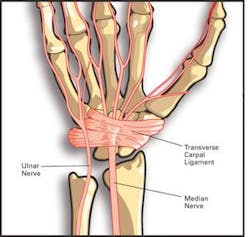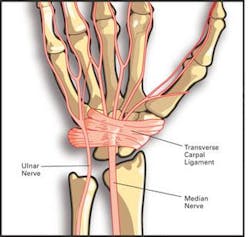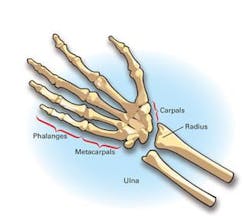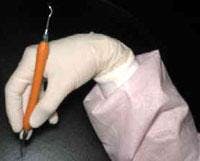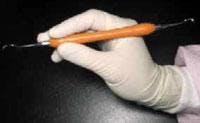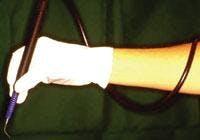Proceed With Caution
by Renee Marks, RDH, MS
What measures did you take today to care for your health and well-being? Perhaps you started your day at the gym, ate a nutritious breakfast, drank your first two glasses of water, and took your vitamin supplements. Then you drove to work in the car you purchased after analyzing the highway safety data reports. Of course, you wore your seatbelt, were aware of dangerous road conditions, and obeyed all traffic laws. Further, in the spirit of safety, you were extremely irritated at the driver in front of you who was talking on a cell phone, taking notes and driving at the same time.
When you arrived at work, were all of these safety precautions forgotten? Did you fall into the old familiar pattern, that of neglecting your personal health and safety? Perhaps this happened as you entered the dental operatory and shifted your focus to your patient and away from yourself. While you value your health and safety outside of work, do you continue to monitor your physical and mental well-being as you proceed through your day as a dental hygienist?
Given the investment of time and money you have made in order to practice the profession of dental hygiene, consider what your career would look like in the future if you acquired a repetitive stress injury, especially to your wrist. You may have heard the saying: "I would have taken better care of myself if I knew I was going to live this long." As you look forward to a productive, healthy, and long life, pay attention to this saying and make the effort to take better care of your own health while at work.
This article reviews the tools and practices commonly used to carry out the supportive maintenance appointment and how they may affect your ability to maintain a healthy wrist and hand. Armed with this knowledge, the goal is for you to take better care of yourself to ensure a long, satisfying, lucrative, and pain-free career.
Your hands are your most important tool
In order to get on board with a sound safety and prevention program, you must first seek to understand some basic information regarding the anatomy of your hand. The hand is composed of many small bones called carpals, metacarpals, and phalanges. The two bones of the lower arm — the radius and the ulna — meet at the hand to form the wrist.
When everything is working as designed, the median nerve, named for the course it travels along the middle of the hand, along with the ulnar nerve, compose the major nerves of the hand. These nerves continue along the length of the arm to transmit electrical impulses to and from the brain. The carpal tunnel is formed by the transverse carpal ligament on the anterior surface of the wrist through which the median nerve and nine tendons pass. A synovial sheath, allowing the tendon to glide as the fingers are moved, covers each tendon.
With repeated overuse, misalignment and stress, you may start to experience tingling, weakness, pain, and finally the need for medical intervention, surgery, or in the worst-case scenario, the inability to continue to practice.
What can go wrong and why?
Although there are several cumulative trauma disorders of the hand, carpal tunnel syndrome (CTS) is the most commonly shared problem among dental hygienists. The syndrome was first mentioned in the medical literature in 1731 by Ramazzini, who described disorders of the hand and wrist associated with performances of repetitive manual jobs in clerks and scribes from "incessant movements of the hand."
Although exact figures are unknown, current estimates are that between 1 and 2 percent of the general population exhibit the syndrome of swelling at the wrist level, resulting in pain, numbness, and tingling known as CTS.
In 2001, research studying 177 Army dental hygienists found 56 percent exhibited probable or classic symptoms of CTS. While it cannot be assumed that this study reflects the entire dental hygiene profession, it does give each of us a personal call to pay attention to our individual posture, working style, and habits.
What we know for sure is that the effects of CTS can extend to the thumb, index finger, and half of the ring finger. The syndrome may include a loss of sensation or feeling in the affected fingers, weakness, dropping of objects, and poor dexterity, all of which are not compatible with dental hygiene practice. In fact, many quality of life activities such as lifting, cooking, hobbies involving fine motor skills, writing, or even flossing can be affected.
Studies by Gelberman and co-workers at the University of California demonstrate that with 90 degrees of wrist flexion, the pressure in the carpal tunnel increases to 94 mm of mercury, while at 90 degrees wrist extension the pressure was 110 mm of mercury. In the neutral position the pressure was 2.5 mm of mercury (see related photographs). For patients with CTS, the mean pressure was 32 mm of mercury at rest. The pressure that builds up when the wrist is flexed in these positions has been described in the literature with the analogy of a garden hose that has a bend or crimp, thereby creating pressure that is not relieved by opening the nozzle.
Looking at your overall health
While job-related stresses are believed to be the key cause of CTS, they are not the only risk factors for development of the syndrome. CTS contributors may include metabolic diseases, such as arthritis or diabetes, and previous trauma to the hand, such as sprains or fractures. Since there is little room for expansion in the carpal tunnel, any condition that causes fluid retention, such as kidney failure, under-active thyroid, or pregnancy may result in the walls becoming compressed, putting pressure on the nerve.
CTS is more common in people who are overweight, have small wrist depth and width ratio, in women who are pregnant or taking the contraceptive pill, and during meno-pause. Therefore, it is important to pay attention to your overall health with regular medical check-ups, a nutritious diet with attention to weight control, and regular exercise.
Equally important are the precautions discussed below that you must take for yourself while treating your patients. The following practices are cited in the literature as the main dental offenders in CTS and other hand and wrist disorders:
• repetitive motions with the fingers in the pinch position
• poor wrist position
• lateral wrist deviations
• working for long periods without rest
• "pulling" motions
• mechanical stresses to the digital nerves from sustained grasps on small diameter hand tools
• use of vibratory instruments with a tight grasp and incorrect wrist position
While the statistics concerning the risk of hand injuries to dental hygienists seem staggering, there is good news for the profession. Attention to ergonomics — the science that seeks to adapt work or working conditions to suit the worker — has gained momentum in recent years. As a result, many dental equipment and instrument manufacturers have made improvements to their products to reduce the stressors.
Since general health and fitness are important to the successful long-term practice of dental hygiene, take care of yourself. Hands and wrists are but one important concern in the bigger ergonomic picture for health and safety in the dental workplace. Among other issues, the practitioner should be attentive to the issue of proper seating height, posture, operatory layout, patient position, and organization of instruments. Psychological stress reduction plays a key role in the overall musculoskeletal health as well. The use of loupes and adequate lighting has been associated with improved overall postural position to preclude shoulder and back trauma. Pay attention to posture and hand position during out-of-office activities, such as computer keyboard use.
As active practitioners, we must focus ourselves to change some detrimental old habits. Ergonomic awareness should begin during our dental hygiene education as an integrated part of the dental practice curriculum. This proactive approach is necessary to accompany the current and continued research being conducted daily and reported in the dental literature by university research centers.
The dental manufacturers response to this research with ergonomically improved tools is beginning to make a positive impact for the health and safety of the dental professional. Pay as close attention to these equipment features and safety practices as you would your car safety reports and road signs.
The life you enhance will be your own.
Reducing environmental risk factors
According to Ergonomics and the Dental Care Worker, edited by Dr. Denise Murphy, preventive strategies include:
• Limit the use of digital motion. Use a secure fulcrum and move the entire hand, wrist and arm. This increased leverage coupled with slow deliberate motions allowing relaxation between strokes, reduces isometric contraction. During isometric contraction, the muscle exerts force but is limited in changing length, which may increase internal frictional force and inflame the digital structures. Just a 10 percent increase in the speed of the stroke can increase the pinch force by 32 percent.
• Maintain sharp instruments. Invest the time and effort in maintaining a good cutting edge. This will insure adequate instrumentation and tactile sense, thereby reducing the amount of repetitive motion necessary to achieve this end.
Author's note: An example of ergonomic initiatives put into the design of products by several manufacturers is illustrated below with a photograph courtesy of Dentsply Professional. These initiatives include improvements in instrument design such as the Flexichange currette. The working ends are changeable and made of stainless steel. This makes it easy to maintain fresh edges. The wide grip made of silicon has a dimple-designed handle for more comfort and the ability to hold and rotate the instrument with a light grasp.
• Take periodic breaks. Take frequent breaks to flex the hand and fingers. Try to alternate your daily appointments between difficult and less demanding procedures.
• Use ultrasonics properly. Maintain a light grasp and let the instrument do the work. Support the cord by wrapping it around your forearm to minimize drag.
• Use properly fitting gloves. Gloves should fit the hand and fingers snugly, but not squeeze across the wrist or forearm. There should be enough glove that the latex wrinkles at the wrist.
• Use automatic instruments in place of hand instruments whenever possible.
Author's note: Studies show that the Cavitron™ Jet removes stain in one third the time of conventional polishing, lessening hand and wrist strain with the use of hand and rotary instruments.
• Use instruments that are lightweight and well-balanced with wider diameter barreled handles.
Author's note: The NUPRO® revolv™ disposable prophy angle is specially designed with a wider back-end and dimple grip for potential fatigue reduction.
• Vary movements, handle size, and instrument grasps throughout the day.
• Handpiece hoses should be pliable and rotate with minimal effort.
Author's note: A 330-degree cable rotation on the Cavitron® Sterimate® handpiece® reduces drag and enables the clinical to position the insert with minimal deviation of the wrist from the neutral position.
Renee Marks, RDH, MS is a clinical educator for Dentsply Professional. She is a graduate of the University of Pittsburgh School of Dental Hygiene and received her master's degree from the Pennsylvania State University. She lectures nationally on the topics of tooth whitening, prevention, ultrasonics and polishing.
References used in this article are available upon request.
